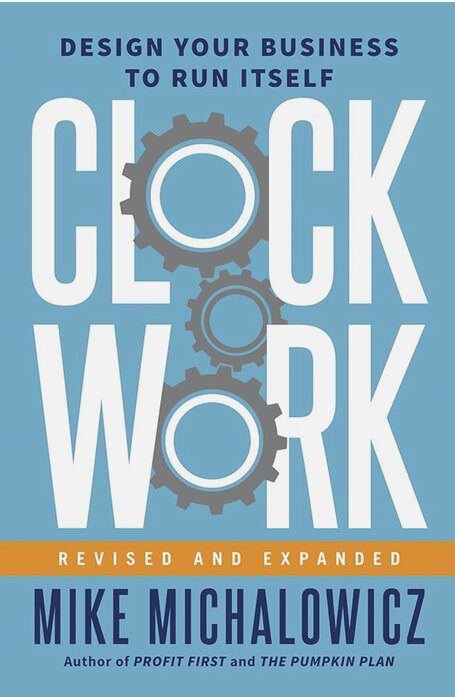In Clockwork, Revised and Expanded: Design Your Business to Run Itself, small business author Mike Michalowicz provides a step-by-step method for getting more done by doing less – making it easier than ever to have your business run itself. Mike suggests that the four-week vacation is the ultimate acid test for a business that runs itself.
There are three stages in a business’s life that every successful entrepreneur experiences. Stage one is when you are scratching your head thinking about starting a business, stage two is surviving the startup stage, and stage three is the growth stage.
Clockwork
Clockwork isn’t about working less as much as it is about living as you intend. When your business runs itself, you have the freedom to do what brings you joy and fulfillment. And to do it without worrying about your business being compromised.
Clockwork is not about abandoning your business, either. It’s about the freedom of choice. If you love aspects of your work, you will have the freedom to lean into that without the need to do the work you aren’t good at or don’t enjoy. If you want to work a twenty-hour week, you can. If you want to take a sabbatical from your business, you can. If you want your business to simply run on its own, permanently, it can. Clockwork does all that for you.
Entrepreneurship Stats
According to research out of Babson University, about 14 percent of the adult population in the US become entrepreneurs and business owners. 1 Which means that if your kindergarten class had thirty students in it, four of your friends went on to become entrepreneurs. But the US Bureau of Labor Statistics reports that only around one third of entrepreneurs are still around at the ten-year mark. 2 Which means, of your kindergarten class, only one person has succeeded as an entrepreneur. And it’s likely that they are funky-monkey exhausted.
“I must do the work myself” problem.
We do the work ourselves to save money. We do the work ourselves because we think no one can do it as well as we do. We do the work ourselves because it’s “just easier” than handing it off to someone we think is too green, too inexperienced, or too incapable of acting like an owner. We do the work, which makes us the only ones capable of doing the work. So we get trapped in an infinite loop and can’t see our way out. We start to lose things—precious memories we can’t get back, a good night’s sleep (or any sleep, for that matter), our interests, time off, and for some of us, even the people we love.
Organizational Efficiency
Productivity gets you in the ballpark. Organizational efficiency gets you hitting home runs. Organizational efficiency is when all the gears of your business mesh together in harmony. It is the ultimate in leverage because you design your company’s resources to work in concert, maximizing their output. Organizational efficiency is when you access the best talents of your team (even a team of one) to do the most important work. It is about managing resources so that the important work gets done instead of always rushing to do what’s most urgent. And it’s about removing yourself from the day-to-day grind so you can make all that happen. Productivity is about doing more to increase output. Efficiency is about doing less to increase output.
Scaling a business is not about less work. It is about different work. You must put less effort into those outcomes, but more thought. The hard work is the thinking.
The Survival Trap
The never-ending cycle of reacting to whatever comes up in your business—be it a problem or an opportunity—in order to move on. It’s a trap because as we respond to what is urgent rather than what is important, we get the satisfaction of fixing a problem. The adrenaline rush of saving something—the account, the order, the pitch, the entire damn day—makes us feel as though we are making progress in our business, but really, we are stuck in a reactive cycle. We jump all about, fixing this, saving that. As a result, our business careens to the right, then to the left. Then we throw it in reverse and jam it forward. Our business is a web of misdirection, and over the years it becomes a knotted mess—all because we were just trying to survive.
The Survival Trap is all about getting through today with utter disregard for tomorrow. It’s about doing what is familiar, as Frank warned. We feel good that we survived the day. But then, at some distant point in the future, we wake up and realize that years and years of work didn’t move us forward one iota, that merely trying to survive is a trap that results in a long, drawn-out drowning of our business and our willpower.
Phases of the Clockwork System
Align Phase
Align is the foundational phase on which organizational efficiency is built. What you gain in this phase you will never lose. To move your business forward toward your desired destination, everyone and everything must move in the same direction. If any part is misaligned, it will impede progress. And if your business has zero alignment—directional anarchy!—it will remain stuck indefinitely.
In the Align phase of Clockwork, you will ensure that what the company does, why it does it, and who it does it for are in harmony. First, you’ll clarify the community you serve. Then, you’ll determine your Big Promise to that group. With this new clarity, you’ll determine your company’s QBR or “Queen Bee Role,” which is the heart of the Clockwork system.
Integrate Phase
In the Integrate phase, you and your team start to see measurable results. This is when your company begins to run like clockwork. Once your business is aligned, it must move forward with all parts in synchronization. In the Integrate phase, the goal is to refocus and reorganize every aspect of your company so your team can do the work in the fewest steps necessary, using the least required effort, to achieve the expected outcome.
First, you’ll discover how you and your team will protect and serve the heart of your organization, the QBR. Then, you’ll track your time and your team’s time in a new way—breaking it down into the Four Ds (4Ds): Doing, Deciding, Delegating, and Designing. This is where you (and your team) will start to do more of the work that you (and they) love to do, the work that brings you (and them) joy and satisfaction. With these 4D insights, you’ll learn how to offload and refocus your to-do list as you determine which tasks you can Trash, Transfer, Trim, or Treasure.
Accelerate
In the Accelerate phase, you take organizational efficiency to a new level. Your team will become more empowered and resilient, you will completely accelerate In the Accelerate phase, you take organizational efficiency to a new level. Your team will become more empowered and resilient, you will completely remove yourself from the “doing,” and your company will grow in impact and profitability. In the Accelerate phase, you will put the best people and resources in place to improve integration. You will permanently help the organization avoid a single person being the “make or break” for the company’s output. Your business will start to run itself. First, you’ll balance your team to ensure everyone is given the tasks and responsibilities that best suit them. Then, you’ll learn a simple process to identify and fix the bottlenecks that interrupt organizational efficiency and slow your team down.
Finally, remove yourself from the “doing,” and your company will grow in impact and profitability. In the Accelerate phase, you will put the best people and resources in place to improve integration. You will permanently help the organization avoid a single person being the “make or break” for the company’s output. Your business will start to run itself. First, you’ll balance your team to ensure everyone is given the tasks and responsibilities that best suit them. Then, you’ll learn a simple process to identify and fix the bottlenecks that interrupt organizational efficiency and slow your team down.
Big Promise.
When you align every aspect of your business with that Big Promise, it provides the level of clarity and certainty you need to design your business to run itself and get your employees on board. Your Big Beautiful Audacious Noble Goal is a driving force for you, and it is your corporation’s purpose. It is not your thing, though. Your thing, your Big Promise, is what you ultimately deliver to your clients and customers. To further clarify, it’s not a specific product or service. It’s what you intend your company to be famous for, that thing your Top Clients value most.
The Big BANG = The driving purpose for what you do. The Big Promise = The number-one thing that your customers value you for.
The Big BANG is your company’s reason for existing and it is how you build cohesiveness across operations.
Capture Systems
Captures are not just about freeing up your time; they ensure that anyone at your company can handle the job if needed. The key is to have each person capture their own system, thereby teaching it to someone else. The last thing you want is for one of your employees to leave without passing on their knowledge—the little tweaks and shortcuts they used to get their job done efficiently that no one else knows about, and the pitfalls and variables that have to be addressed. All that should be passed on through Captures.
My observation is that whenever one person is found adequate to the discharge of a duty, it is worse executed by two persons, and scarcely done at all if three or more are employed therein. – George Washington
The only true failure is idleness, where you don’t make any decisions. Stop training your employees to be idle by deciding for them. Have them move your business forward by empowering them to make decisions.
Hire diversity.
Don’t hire people you like; hire people you respect. Finally, be a trait-seeker. Look for employees with the traits and strengths you need. In your trait-seeking role you will want to determine whether this person needs to be super detail-oriented, or a great communicator, or analytical. Consider the different jobs you need completed at your office and the specific strengths those jobs need, and then hire for them.
The four core parts of your business: Attracting (leads), Converting (sales), Delivering (your promise), and Collecting (their promise).
All the best in your quest to get better. Don’t Settle: Live with Passion.



Comments are closed.